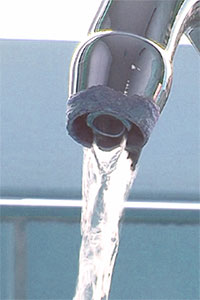 |
|
|
|
You are in: Future Challenges : Peak Water
Peak Water
With oceans covering over seventy percent of the planet, the idea that we may in the near future run out of water may seem ludicrous. However, "Peak Water" refers to a state of affairs in which our supply of fresh water is not replenished at the rate it is consumed. Ninety-seven per cent of all water on the Earth is salty. The majority of all fresh water is then frozen in the polar icecaps. Most of the rest is in the soil or inaccessible deep underground. The tiny percentage of fresh water suitable for human and animal consumption therefore comes from lakes and accessible underground sources. Because the clean water in lakes and accessible underground aquifers behaves like a finite resource, if current usage patterns continue the United Nations predicts that by 2025 1.8 billion people could be short of water, with two thirds of the world population experiencing stressed or restricted supplies. Indeed, United Nations Secretary General Ban Ki-Moon has repeatedly warned that water scarcity will threaten economic growth, human rights, health and safety and national security within a couple of decades. The United Pages relating to water scarcity and its implications can be found here. Regional Variations
As water is not an easily transportable resource, different parts of the world will face different Peak Water situations. Already many regions are experiencing or will soon face peaks in their production of water from underground acquifers. For example, in Delhi, Rajasthan and many other parts of India ground water is being drained at almost twice its natural rate of replenishment. Other countries over-pumping their groundwater aquifers include China, Iran, Israel, Mexico, Spain and the United States. In total, around half of the world's population live in countries where the water table is falling, and sometimes at an alarming rate. For example, the aquifer under Hebei Province in the heart of the North China Plain is dropping nearly three metres a year. In the North Gujarat region of India the water table is falling by double this amount. With wells in these regions having either dried up or needing to be sunk deeper and deeper each year, agriculture is inevitably starting to suffer and crisis looms. Another pressure on future fresh water supplies is climate change. Even small changes in global temperatures are already altering the intensity and duration of rainfall, causing lakes to evaporate more rapidly, and so precipitating more droughts. Regions dependent on runoff water from glacial melt are also going to face local Peak Water situations due to a loss of glaciers. Not least this will be a significant issue in China where many major rivers are replenished from glacial melt. More broadly, as the planet warms, the demand for drinking water will also rise, as will the requirement for irrigation systems to grow crops previously watered by the rain. Peak Water ImplicationsWith about 70 per cent of the water appropriated by humanity being used in agriculture, Peak Water will almost inevitably be a major cause of future food shortages. Already the production of wheat in China is falling due at least in part to water shortages. Saudi Arabia also expects to have to phase out its wheat production completely due diminishing fossil groundwater supplies. Peak Water will also have major business implications. At present about 22 percent of all appropriated fresh water supplies are used for industrial purposes. As reported by Circle of Blue, Peak Water will therefore trigger a global industrial transformation. Not least major industries are likely to have to relocate to regions with adequate fresh water supplies. For example, manufacturers in the United States may in future have to move from the increasingly dry Southwest back to the water-rich Great Lakes region. More information on Peak Water can be found in my book 25 Things You Need to Know About the Future. A list of Peak Water web references can be found here. Return to Future Challenges. |
 By 2025, two thirds of humanity will face stressed or restricted fresh water supplies.  Learn about Peak Water solutions |
|
|